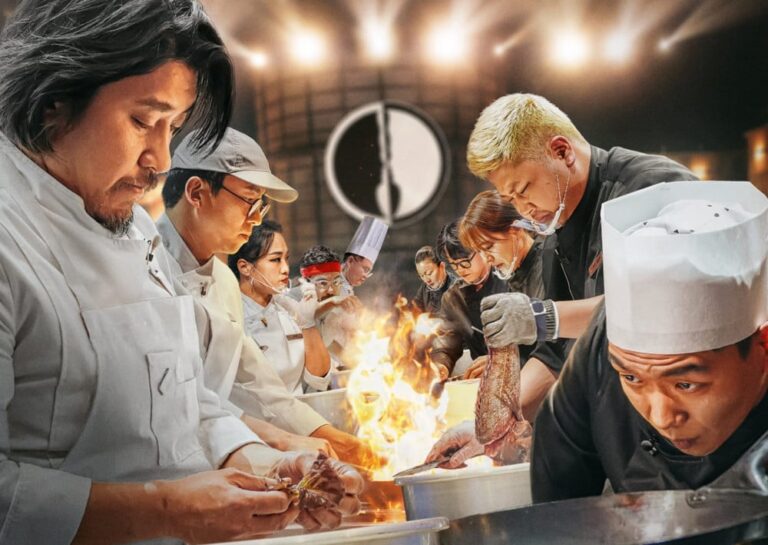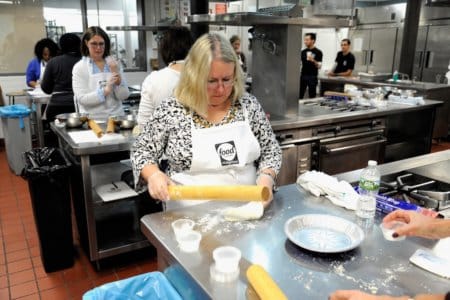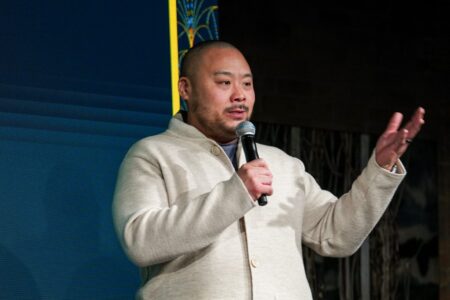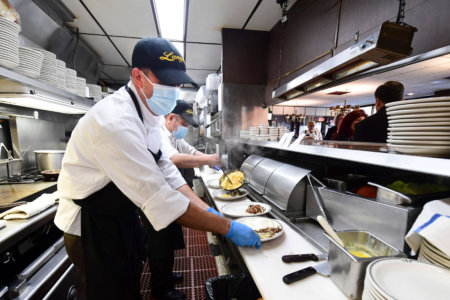
The knives are out on Netflix’s newest reality TV hit, Culinary Class Wars.
If you haven’t been binge-watching it, it’s just like MasterChef and Iron Chef — except on steroids.
It’s way more high stakes and with a lot more contestants — as many as 100 chefs, with 20 elite Michelin-starred, ex-MasterChef, ex-Iron Chef going head-to-head against 80 underdog chefs.
Led by chef and food researcher Paik Jong-won and three-Michelin-starred chef Ahn Sung Jae, each episode is a thrilling battle of skill and creativity — making it to Netflix’s top 10 most-watched list across 28 countries.
Impressively, it has held the top spot on Netflix’s Global TOP 10 TV (Non-English) chart for two weeks in a row.
We want to be just as passionate in creating magic through food just like the contestants — the question is: how do you even become a chef

Throughout Gordon Ramsay’s career, he has earned a total of 17 Michelin stars. Source: AFP
How to become a chef: Culinary school vs apprenticeships
You have two options: culinary school or apprenticeship.
Both paths offer unique advantages, and your choice largely depends on your learning style, career goals, and financial situation.
Culinary school gives you an all-around education in cooking, from basic knife skills to advanced techniques. It’s more structured, but it can be expensive and doesn’t always provide much time in a real kitchen.
On the flip side, apprenticeships let you dive right into the action, learning on the job and getting paid (though not a lot) as you go. But without the basics, the fast pace might leave you behind.
Whether you choose culinary school or an apprenticeship, both paths can lead to success. After all, some of the world’s most popular Michelin-star chefs didn’t attend culinary school.
Eight Michelin stars chef Gordon Ramsay earned a degree in hotel management at North Oxon Technical College.
Thomas Keller, the first American chef to earn two three-star Michelin ratings, learned by working under esteemed chefs in the US and success.
While these chefs prove that formal schooling isn’t a must for culinary success, many employers still value the skills and discipline that come with a structured education — or, in the case of Chef Ahn, a stint in the US Army.
Ahn Sung Jae was a solider before he was a chef
Ahn Sung Jae’s family moved to America when he was 13 years of age, where he used to help out at his parents’ Chinese fast-food restaurant.
And no, he didn’t quite like it, but that experience would be the seed of his hard work ethic.
He then served in the US Army, and got deployed to Iraq for one year to save some money to fund mechanic school.
But two weeks before school was due to start, he saw a bunch of people in white uniforms walking down the street while he was driving — they were students of the Le Cordon Bleu College of Culinary Arts Los Angeles.
That day itself, he went in to speak to a counsellor. Believe it or not, the rest was history.
Ahn would go on to graduate from Le Cordon Bleu. He dove into the luxury dining scene throughout California, working his way up the ranks.
Urasawa, a luxury Japanese restaurant in Beverly Hills. The French Laundry, a three-Michelin star French and Californian cuisine in a rustic farmhouse. Benu, a two-star restaurant, Aziza, a Moroccan restaurant, and more.
These are places worked at before opening his first ever restaurant in San Francisco. It was named Mosu, a play on the Korean word for cosmos flowers — an ode to his childhood frolicking in fields of cosmos.
In just one year, the restaurant would earn its first Michelin star. In 2017, however, family would come calling in South Korea. He closed the restaurant, packed his bags, and relocated his family and the restaurant to the East Asian nation.
In 2017, Mosu opened in Seoul, and it would be nothing the people had ever seen before.
Nobody can fully describe the depth of his cuisine — a mix of Korean, Japanese, even French. But those layers of delicate flavouring to each and every one of his meals is inspired by a childhood memory.
His famous abalone tacos — tacos made out of a protein layer called Yuba, and the taste of abalone filling amplified by seaweed — was a recipe he developed, thinking about the days he’d walk down lots and lots of burrito and taco shops in California.
In 2022, the restaurant would become the first and only three-star Michelin restaurant in South Korea. The same year, he would move on to open Mosu Hong Kong.
This year, Mosu is facing temporary closure after a parting with an investor. They’re set to relocate to a new, bigger location in 2025 — so if you know you’re going for a visit next year, get your spots booked.
Ahn Sung Jae is the example of a pioneering chef who did it the traditional way. He went to culinary school, worked his way through the ranks in different restaurants, and with enough experience working in other chef’s kitchens, finally opened his own.
But did the other chefs on Culinary Class Wars take the same journey?
The education of 8 Culinary Class Wars chefs you probably didn’t know

Edward Lee had the honour of preparing the meal for the 2023 White House State Dinner welcoming the President and First Lady of South Korea in 2023. Source: AFP
Edward Lee
Chef Edward Lee’s journey is a testament to following one’s passions. Growing up in Brooklyn as a Korean-American, his heart was split between two worlds: food and literature.
Initially envisioning a life as a writer, he graduated magna cum laude from New York University with a degree in literature. However, the vibrant energy of restaurants called to him.
Today, he proudly leads the kitchen at 610 Magnolia in Louisville, Kentucky, where his culinary talents have earned him recognition as a four-time James Beard Foundation Best Chef nominee.
Beyond the kitchen, he co-founded LEE (Let’s Empower Employment) and set up 19 relief kitchens across the US to support farms hit hard by the COVID-19 pandemic.
View this post on Instagram
Jung Ji Sun
While attending a commercial high school, “Queen of Dim Sum” chef Jung Ji Sun earned a computer-related certificate but quickly realised it wasn’t her true calling.
She took a part-time job as a dishwasher and with her hard-earned savings, she enrolled in the Hotel Culinary Arts Department at Hyejeon University.
Upon graduating, she set off for China with hopes of studying at Yangzhou University. Despite arriving without a language certificate and limited knowledge of the Chinese language, she immersed herself in Chinese studies, ultimately securing admission after months of effort.
Now, she’s the head chef at Tian Mi Mi, and after appearing on Culinary Class Wars, her restaurant’s sales have skyrocketed — almost tripling.
Kang Seung Won
Meet Chef Kang Seung Won, one of the top three finalists on Culinary Class Wars. His passion for cooking sparked in elementary school, leading him to Le Cordon Bleu and a series of stints in Michelin-starred kitchens.
He was the sous-chef at Mosu, working alongside Culinary Class Wars judge Ahn Sung Jae, and also worked at Benu, a three-star gem in San Francisco.
Currently, he owns Trid, a contemporary fine-dining restaurant that has earned recognition in the Michelin Guide Seoul for three consecutive years.
Fabrizio Ferrari
Fabrizio Ferrari, affectionately called Chef Fabri in Korea, is one very experimental Italian Michelin 1-star chef. His love for Korean food kicked off when he teamed up with Park Song Gu, his Korean sous chef, who was eager to gain some Italian culinary experience.
Blown away by Park’s passion and commitment, their collaboration opened doors to the Korean community in Italy, where they started cooking up some delicious micro-fusion dishes.
Since then, he’s dedicated himself to advancing Korean food culture by teaching at the Sejong Culinary Institute of Asia, creating engaging content on his YouTube channel (“Itali Fabri”) and serving as a judge in competitions like the Kimchi Master Chef Competition.
View this post on Instagram
Choi Kang Rok
Choi Kang-rok became a fan favourite on Culinary Class Wars, delivering memorable moments and humorous lines like, “This set is all fiction. Let’s not be NPCs,” and “I’m all about perilla oil.”
Before his culinary career, Choi briefly studied Spanish but enlisted in the Marine Corps during the IMF crisis. After serving, he worked part-time at a pork cutlet restaurant and a Japanese eatery to fund his passion for music.
His career took a turn when he, inspired by the cartoon Mr Sushi King, pursued cooking and opened his first sushi restaurant at 24. However, he struggled due to inexperience.
At nearly 30, he moved to Japan, where he quickly learned Japanese at a temple and attended Tsuji Culinary Institute.
After graduating, he returned to Korea as a faculty member at a Japanese Cuisine Academy. His entrepreneurial spirit led him to open a Japanese side dish restaurant in Jamsil, but he closed it after incurring significant losses.
To pay off debts, Choi worked at a tuna trading company and, while drunk one night, applied for MasterChef Korea 2, ultimately winning the competition. Then, in April 2022, he opened Neo, an Omakase Japanese restaurant in Samjeon-dong, which continues to thrive today.
Choi Ji-hyung
Choi Ji-hyung did more than turn the Korean street food staple sundae, or blood sausage — pig intestine — into a luxurious art that’s now featured in the Michelin Guide for Seoul. He’s the owner of the restaurant Lee Buk Bang, bringing North Korean cuisine to the fine dining scene in South Korea.
The 37-year-old chef takes his heritage into his food. His grandmother was a refugee from the Hamgyong province in North Korea, and these were the kinds of foods he grew up on.
“I wanted to make a place where people can get the energy to heal the daily stress of today from my simple but warm dishes like grandmother’s home-made meals,” he told the South China Morning Post.
Choi earned his bachelor’s and master’s degree in culinary arts at Johnson & Wales University in Rhode Island, and has experience working in a variety of two- to three-star Michelin restaurants.
Oh Se-deuk
A certified celebrity Chef, Oh Se-deuk’s face and humorous personality may be familiar to you if you’ve watched the South Korean programme, “Please Take Care of My Refrigerator.”
But he’s snagged the celebrity title not just because of his character on Korean television.
Oh runs two restaurants in the serenity of Jeju Island — Chinmeal, of French cuisine, and Oh Pan Fire, an American restaurant. He’s the definition of someone who’s unafraid to explore, using traditional Korean ingredients to spice up French recipes.
He told the Korea JoongAng Daily back in 2012, that his culinary dreams were realised thanks to a high school girlfriend. “I wanted to impress her, so I told her that I would become a world-famous chef one day and that I would cook her the best dishes from around the world,” he said.
Oh Se-deuk graduated from the Institute of Culinary Education in New York in 2002.
View this post on Instagram
Park Joon-woo
The cuisinier-pâtissier-traiteur — meaning “cook, pastry chef, and caterer” in French — would find an impetus to start cooking through the art of words. Born in South Korea, Park Joon-Woo and his family moved to Belgium when he was 18 years old.
His dreams would take a couple of different shapes before he found the art of patisserie.
He dropped out of a modern languages programme in university and quit working as sculptor before taking on a five-month cooking course.
But it’s only when started writing about the culture of Belgium food in a blog that he began to develop a passion for food.
When Park returned to South Korea, he took part and became a runner-up in season one of Masterchef Korea.
But his real calling is in delectable sweets. Park currently owns the artsy retreat of Aux Petits Verres, a European-style cafe in Seoul overflowing with desserts and Belgian beer.










